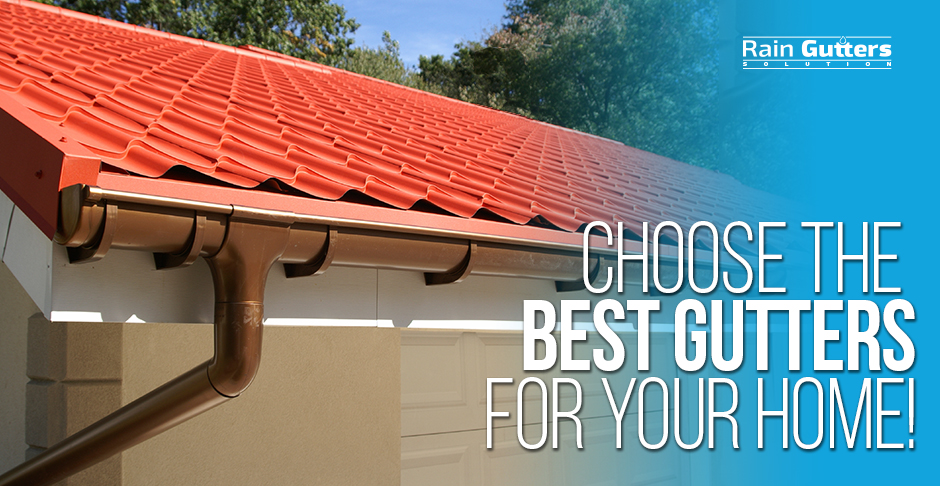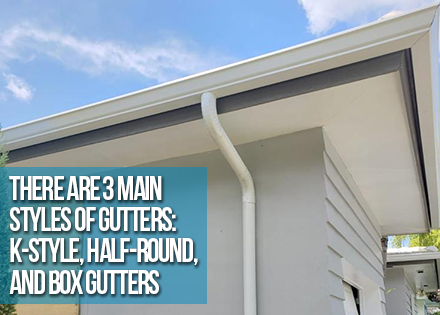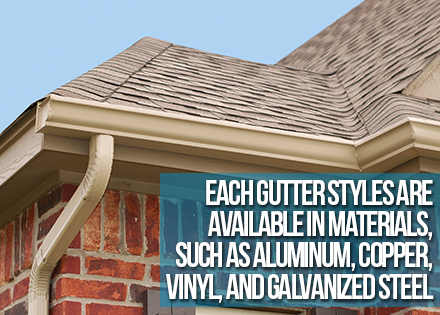Which Types of Gutters Are Best?
July 05, 2022

A rain gutter is the best way to prevent flooding, dampness, and moisture around your property. This remains true as long as you get a professional
Rain Gutter Installation Service to build the type of gutter that your home/business needs. After all, rain gutters don't follow a single standard, and a commercial establishment can't get a gutter that would fit better in a household. Installation companies offer a series of guttering profiles, with different shapes and sizes to match all kinds of roofs.
What Are the Best Types of Gutter?
Even if they've never had a rain gutter, most people can recognize the most common gutter designs. Modern gutters cater to all types of architecture, and each gutter style is meant to suit a particular building structure without sacrificing efficiency.

Based on the design, these are the three main types of rain gutters:
- K-style Gutters: K-style gutters have a flat bottom and a slight curve at the front that resembles crown molding. They're currently the most popular type of gutter in the U.S., mostly due to their versatility and water-holding capacity. They're also easy to build with a gutter-making machine, in any width from 5 inches to 8 inches. Lastly, the shape of k-style gutters helps them blend in beautifully with modern constructions.
- Half-Round Gutters: These gutters have a semicircular shape that curls outwards at the front. Usually made with a 5-inch/6-inch width, half-round gutters are very well-liked among homeowners. Depending on their size, they may offer some limitations in the drainage department, but a larger gutter profile can efficiently keep up while redirecting large amounts of water.
- Box Gutters: This is the most common choice for large structures like malls, hotels, warehouses, office buildings, etc. They can also be found as part of older architecture like traditional households or historic buildings. As the name implies, a box gutter has a square/rectangular shape, usually covering a large space below the roof to catch more water comfortably.
Both k-style gutters and box gutters work well with rectangular downspouts, while half-round gutters are made to fit perfectly with round downspouts. A custom gutter, however, can widen your options to combine different-sized gutters and downspouts.
As you can see, each gutter style works best under certain circumstances. They all offer versatility and effectiveness as long as you combine the gutter design with dimensions that match your roof's measurements.
If you live in a very rainy area, a k-style gutter is probably the best choice, as it can hold more water than a half-round gutter with the same diameter. On the other hand, half-round gutters simplify maintenance because they don't have corners for the debris to get stuck. With these gutters, external elements tend to follow the rainwater down the downspout, resulting in less dirt during your regular cleaning sessions.
Gutter Materials
There's also a variety of rain gutter materials for people to choose from according to their priorities. Since all materials offer a certain level of durability, some people simply pick the material that looks better. Others go for the sturdiest and thickest option available.
Choosing the material for your gutter is no small thing. Your decision can enhance or hinder the end result even after you have your mind set on a particular gutter style.
The most popular rain gutter materials are:
- Aluminum: Probably the most popular choice. Aluminum gutters are lightweight and flexible, so they're easier to install than other metal gutters. They're also durable, lasting for 20-40 years without showing signs of deterioration. Aluminum is the ideal material to manufacture seamless gutters.
- Steel: Gutters can be made with galvanized steel or stainless steel, with the later offering enhanced rust-resistance. Heavier than aluminum gutters, steel gutters are also very durable, working like a charm in any type of weather. Because of their weight, their installation should be left to professionals.
- Copper: Copper gutters are the sturdiest option around and probably the safest choice if you want maximum durability to fight the elements. They're also visually appealing, with their natural color slowly making way for a green patina that many homeowners find appealing. Copper gutters are very heavy, and this is a double-edged sword. On the one hand, this helps copper gutters hold their own against nearly any type of weather; on the other hand, it also makes installation trickier and results in a higher price range.
- Vinyl: They're the least expensive option and they're light enough to simplify most of the installation process. Vinyl gutters are available in various colors but can also be painted to match a particular color scheme. Keep in mind that vinyl is also the most vulnerable material of the bunch; continued sunlight can gradually dull down its color. More importantly, intense weather changes can cause a lot of damage, bending the gutter and warping its shape.
Sectioned or Seamless?
Rain gutters can also be classified according to the installation method. You can probably tell the differences between sectioned gutters and seamless gutters from their names alone. The former is built from multiple separate sections that are attached together before installing the assembled piece below the fascia. The latter is made with a metal-bending machine, shaping the material into one large guttering system that's tailored around the building's measurements. This means that seamless gutters have no joints along their length, save for the corners and the outlet connected to the downspout.

The lack of seams brings many advantages that wind up improving the gutter's performance. For one, there are fewer clogs because leaves, debris, and other outside elements are less likely to get stuck inside. The water also flows more quickly toward the downspout, with more room to hold copious amounts of rainwater during a storm.
Seamless gutters last much longer and are easier to maintain, usually offering other esthetic advantages when you hire a professional installation service. However, if your gutter needs repairs, you don't have the option to dismount a portion of the gutter without bringing down the whole system, as seamless gutters have no sections to separate the final result into parts once it's in place.
In the end, the pros of seamless gutters far outweigh the cons, but you can always seek the informed opinion of a professional contractor to evaluate your home and help you come up with the best option.
Get the best gutters for your home or business. Rain Gutters Solution tailors your guttering system according to the best fitting profile. If you want to schedule an appointment with our specialists, or just learn more about the different types of gutter available, call
(305) 270-7779 or fill out the
contact form. We'll give you all the options you can ask for to build the perfect rain gutter for your home or business.
If you found this article helpful then let us know in the comments section below. Likewise, feel free to share it using the share options below. Want us to cover another topic of your interest pertaining to rain gutters? If so, then like us and follow us on social media, and post to any of our social media profiles the topic you'd like us to discuss:
Facebook @RainGuttersSolution,
Twitter @Gutterssolution and
Instagram @RainGuttersSolution


 The lack of seams brings many advantages that wind up improving the gutter's performance. For one, there are fewer clogs because leaves, debris, and other outside elements are less likely to get stuck inside. The water also flows more quickly toward the downspout, with more room to hold copious amounts of rainwater during a storm.
The lack of seams brings many advantages that wind up improving the gutter's performance. For one, there are fewer clogs because leaves, debris, and other outside elements are less likely to get stuck inside. The water also flows more quickly toward the downspout, with more room to hold copious amounts of rainwater during a storm.